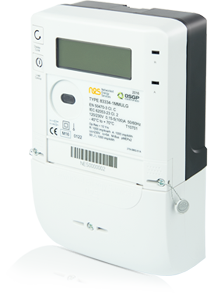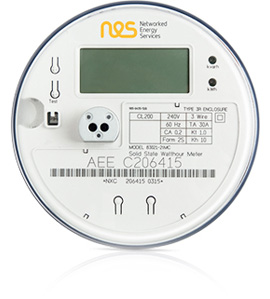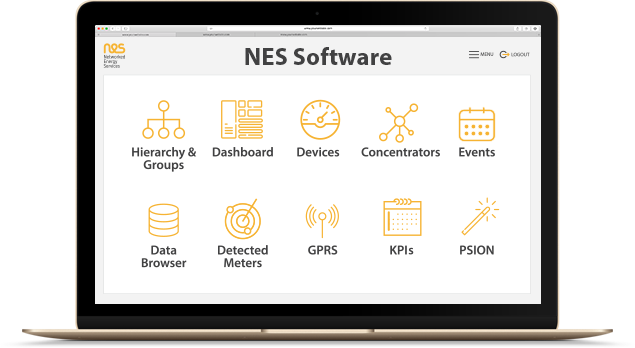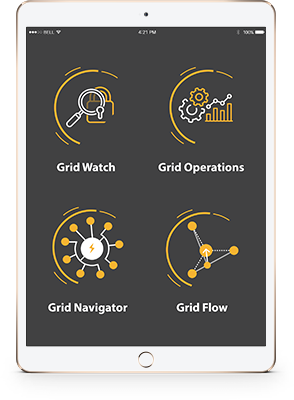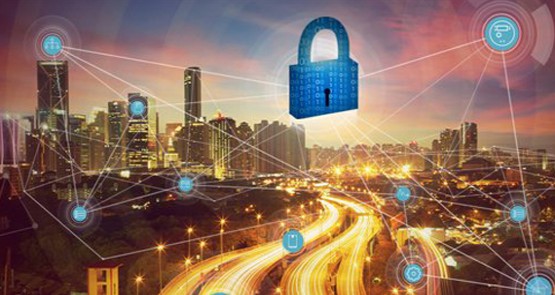Energy Applications
Security Applications
Smart Meters
Control Nodes
Control Point Modules
Software
Service & Maintenance
NES Corporation offers the most reliable, broadly deployed smart grid platform enabling grid health and efficiency monitoring as well as control and smart metering applications. The NES System is based on a 3 tier architecture; the offering includes utility data center software, field distributed application control nodes and grid devices and sensors, such as single phase, poly phase, and CT smart meters, and Open Smart Grid Protocol (OSGP) compliant communication devices enabled by our Control Point Modules.
A true Smart Grid employs meters, which act as sensors reporting back many supply quality, local consumption and generation parameters, and health indicators. NES smart meters and distributed control nodes (e.g. data concentrators) embedded in the low-voltage network provide this functionality, and, in fact, they are computational processing resources with memory and processing power. These devices can be securely configured over the network, so that the functions of the Smart Grid can be modified over time to fit with regulatory requirements, exploit market opportunities and leverage innovative technologies. This will be needed as micro-generation and electric vehicles continue to gain popularity, and demand response, at the scale of the low-voltage grid, starts to become reality. This, coupled with an open smart communications protocol, will allow the underlying topology of the grid to be exposed and enable improved operations.
NES has designed its sophisticated, flexible, upgradable smart meters and distributed control nodes to be secure from inception at a foundational layer. Options for connectivity and integration, at the meter, distributed control node and head-end system allow for omni-directional flow of energy and information, integration of that information with other systems, automation, and control. Sensor capabilities and analytics solutions provide new levels of visibility for the low-voltage grid, enabling a Smart City to gain control of energy flows, efficiency, and the balance of consumption and generation in this increasingly dynamic environment.
Reliable Smart Meters
Reliable, field-tested and accurate, the NES Smart meters are based on NES’s proven communication technology used in millions of smart meters, making it Europe’s market leading solution. With daily communication reads proven to deliver 99.8-100% reliability, NES’s Smart Metering Solution consistently provides utilities with the power consumption and power quality data they need to gain visibility at the edge of the grid.
Heightened demand for power availability, distributed generation, and greater efficiency are creating a need for more consumption and power quality measurements at the edge. To meet this need, NES smart meters offer 4 sets of load profile data. Each data set can include up to 16 channels, and can be configured independently for interval, size and collection settings. Also, NES Meters provide options that allows accommodation of auxiliary meters (gas, water, heat) through a standards compliant interface, and is fully capable of securely connecting to wireless or wired devices for Home Area Network (HAN) integration, energy management or other expanded services.
Intelligent Distributed Control Nodes
The NES Distributed Control Nodes (DCN) are intelligent infrastructure devices that let a utility leverage its NES System solution beyond smart metering. The DCNs provide management capabilities to ensure 100% meter communications, isolate and pinpoint outage and other service issues, and minimize wide-area communications costs. They communicate with System Software located at a utility’s service center over any IP-based backhaul.
The DCN’s computing power and Linux operating system provides a strong built-in platform for adding additional drivers and distributed applications that allow utilities to adapt to the changing needs of your low voltage distribution grid. This expansion ability enables utilities to expand sensor connectivity at the transformer, stay ahead of necessary security requirements in the industry and take advantage of exciting new functionality from NES as it is made available.
NES System Software makes integrating with new and existing enterprise applications via IT standards fast and easy. This Service-Oriented Architecture (SOA) software has been proven in numerous utility deployments. Built for automating and managing millions of smart meters and grid devices, NES System Software is the proven management system that forms the foundation of a smart grid system. It supports everything a utility needs to deploy, provision, configure, audit, diagnose and retrieve data from their smart meters and Open Smart Grid Protocol (OSGP) enabled grid devices. It’s fault-tolerant, tested to scale to millions of meters, and built on IT standards for faster, easier, and less error-prone integration. System Software provides the two-way grid intelligence utilities need for a more stable, reliable and smarter grid today.
Extensible System Software
System software is designed to take advantage of NES’s intelligent, distributed architecture to collect data in the most efficient way reducing WAN costs, IT server bandwidth and delivering the right data, at the right time, to the right place. With local intelligence in NES devices, all events do not need to be processed at the head-end to take action or process data reducing data deluge.
Instead, action can be taken in the field when necessary. Information brought back to the data center can then be distributed across multiple departments and used in many different applications to enable a proactive posture, provide troubleshooting analysis, and settle customer bills. With this ability, utilities can reduce mean-time-to-repair and avoid expensive emergency after-hour repairs.
System Software is an extensible infrastructure that enables a full range of valuable applications that can improve every aspect of a utility’s operation – from metering and customer service to distribution operations and value-added business. It has been optimized for bandwidth, to efficiently pull data with minimum incremental costs and is not limited by the number of applications it can support. For additional operational costs savings, software enabled features like our remote disconnect/reconnect switch and secure remote firmware upgrades allow you to manage rate plans, add time-of-use tariffs or update meters through software, eliminating trips to the field.
It also easily integrates with leading meter data management (MDM) solutions available from solution providers like Siemens, Oracle, Görlitz, Schneider Electric, Powel, and many others. Designed with interoperability in mind, the software communicates using standard Web services interfaces (e.g. XML and SOAP) to the utility’s applications such as billing, CRM, customer service, operations, workforce management and integrates into Enterprise authentication services such as Microsoft’s Active Directory as part of the overall security architecture.
NES Energy Applications Platform (EAPTM)
With demand for electricity increasing year after year and new regulations that require greener and more efficient systems, utilities have come to face unprecedented challenges.
Utilities now need a better way to modernize and manage their systems. That is why NES developed the Patagonia energy applications platform (EAPTM), a sophisticated and secure hardware and software platform that transforms existing power distribution networks into smart grids with orchestrated distributed intelligence, command and control. NES EAPTM provides a powerful, secure and flexible platform with hundreds of potential applications from energy balancing and transformer load management to proactive health monitoring. The system can display detailed energy balance data over time to help utilities better manage supply and demand, detect meter to transformermis-wiring and voltage imbalances across phases, and utilize topology data to pinpoint failing equipment and outages.
Patagonia employs advanced technology to automatically map the physical topology of the low-voltage grid, making it possible for utilities to see, control and automate their networks in ways that weren't possible before. With Patagonia EAPTM, smart meters located at the edge of the grid perform their traditional billing role while also acting as low-voltage distribution sensors that collect data on grid health, power quality and usage statistics. Control nodes then utilize data from smart meters to generate topology maps of the grid and make autonomous management decisions that enhance the efficiency and reliability of the low-voltage grid.
